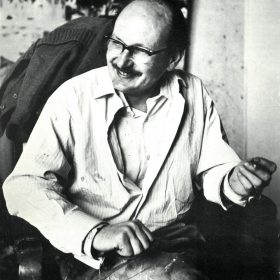In The Road to Fochabers, Blyth has placed himself in the country hedgerows of near Elgin, the low evening sun illuminating the high ground, plunging the rest into shadow. He has sought to capture the texture of the landscape, indicating the long grasses by drawing into the wet oil paint with the back of his brush, a technique much favoured by his direct contemporary Joan Eardley. Like his friend and colleague Ian Fleming, Bobby Blyth moved to Gray’s School of Art in Aberdeen by ways of Glasgow and Hospitalfield House near Arbroath. He became Head of Painting at Gray’s in 1960 before his premature death in 1970. He was a painter’s painter and was renowned for his brilliant, original draughtsmanship and eye for compositional design. Like Fleming, Blyth found much of his subject matter in the landscape of Aberdeenshire.

Robert Henderson Blyth was a distinctive voice in post-war Scottish painting, known for his expressive treatment of the landscape and his subtle shift towards abstraction. Born in Glasgow, Blyth studied at the Glasgow School of Art from 1934-1939. A painter of considerable sensitivity, he served during the Second World War, an experience that left a lasting impression on the emotional undercurrents of his work.
After The War, Blyth quickly gained recognition, receiving the Guthrie Award from the Royal Scottish Academy in 1945. He began teaching at Edinburgh College of Art from 1946 and later became artist-in-residence at Hospitalfield House, Arbroath a centre known for its vital role in developing post-war Scottish modernism. In 1954, Blyth moved north to take up a post at Gray’s School of Art in Aberdeen, becoming Head of Drawing in 1960, a role he held until his untimely death in 1970.